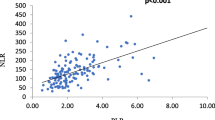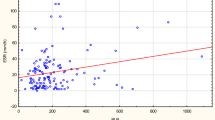Abstract
Neutrophil-to-lymphocyte ratio (NLR), monocyte-to-lymphocyte ratio (MLR), and platelet-to-lymphocyte ratio (PLR) have been investigated as disease activity markers for systemic lupus erythematosus (SLE). Hence, we investigated the clinical significance of these parameters in diagnosing infection in patients with SLE. In total, 120 patients with SLE, who were admitted to hospital due to disease flares or infection, were recruited for the study. Of the 120 patients, 60 had a concurrent infection (SLE with infection), while the remaining 60 patients were admitted with a flare without any evidence of infection (SLE with flare). NLR was higher in the patients with SLE with infection, compared to patients with SLE with flare (14.2 ± 15.4 versus 3.3 ± 2.2, p < 0.001). Additionally, PLR was higher in the SLE with infection group than in the SLE with flare group (357.7 ± 350.1 versus 231.7 ± 152.9, p = 0.012), but not MLR. In the SLE with infection group, C-reactive protein (CRP) levels positively correlated with NLR and PLR. NLR with a cut-off value of 5.70 and an area under the curve (AUC) of 0.872 indicated good sensitivity (75%) and specificity (90%), for the diagnosis of SLE with infection. CRP with a cut-off value of 1.28 mg/dL (AUC 0.942) showed the sensitivity (93.3%) and specificity (91.7%). NLR with a cut-off value of 5.70 and CRP with a cut-off value of 1.28 mg/dL showed the increased specificity (98.3%) than only CRP, but not significant. NLR could be a good additive marker for diagnosing infection in patients with SLE.


Similar content being viewed by others
References
Rigante D, Mazzoni MB, Esposito S (2014) The cryptic interplay between systemic lupus erythematosus and infections. Autoimmun Rev 13:96–102
Navarra SV, Leynes MS (2010) Infections in systemic lupus erythematosus. Lupus 19:1419–1424
Wadee S, Tikly M, Hopley M (2007) Causes and predictors of death in South Africans with systemic lupus erythematosus. Rheumatology (Oxford) 46:1487–1491
Ospina FE, Echeverri A, Zambrano D, Suso JP, Martinez-Blanco J, Canas CA, Tobon GJ (2017) Distinguishing infections vs flares in patients with systemic lupus erythematosus. Rheumatology (Oxford) 56(suppl_1):i46–i54
Gao J, Zhang L, Zhang X, Zhao SL, Liu SY, Xing LH (2016) Levels of serum procalcitonin and C-reactive protein for evaluating pulmonary bacterial infection in patients with lupus erythematosus. J Huazhong Univ Sci Technolog Med Sci 36:653–658
Kim HA, Jeon JY, An JM, Koh BR, Suh CH (2012) C-reactive protein is a more sensitive and specific marker for diagnosing bacterial infections in systemic lupus erythematosus compared to S100A8/A9 and procalcitonin. J Rheumatol 39:728–734
Pyo JY, Park JS, Park YB, Lee SK, Ha YJ, Lee SW (2013) Delta neutrophil index as a marker for differential diagnosis between flare and infection in febrile systemic lupus erythematosus patients. Lupus 22:1102–1109
Suh CH, Jeong YS, Park HC, Lee CH, Lee J, Song CH, Lee WK, Park YB, Song J, Lee SK (2001) Risk factors for infection and role of C-reactive protein in Korean patients with systemic lupus erythematosus. Clin Exp Rheumatol 19:191–194
Suh CH, Chun HY, Ye YM, Park HS (2006) Unresponsiveness of C-reactive protein in the non-infectious inflammation of systemic lupus erythematosus is associated with interleukin 6. Clin Immunol 119:291–296
Mercan R, Bitik B, Tufan A, Bozbulut UB, Atas N, Ozturk MA, Haznedaroglu S, Goker B (2016) The association between neutrophil/lymphocyte ratio and disease activity in rheumatoid arthritis and ankylosing spondylitis. J Clin Lab Anal 30:597–601
Yang W, Wang X, Zhang W, Ying H, Xu Y, Zhang J, Min Q, Chen J (2017) Neutrophil-lymphocyte ratio and platelet-lymphocyte ratio are 2 new inflammatory markers associated with pulmonary involvement and disease activity in patients with dermatomyositis. Clin Chim Acta 465:11–16
Wu Y, Chen Y, Yang X, Chen L, Yang Y (2016) Neutrophil-to-lymphocyte ratio (NLR) and platelet-to-lymphocyte ratio (PLR) were associated with disease activity in patients with systemic lupus erythematosus. Int Immunopharmacol 36:94–99
Qin B, Ma N, Tang Q, Wei T, Yang M, Fu H, Hu Z, Liang Y, Yang Z, Zhong R (2016) Neutrophil to lymphocyte ratio (NLR) and platelet to lymphocyte ratio (PLR) were useful markers in assessment of inflammatory response and disease activity in SLE patients. Mod Rheumatol 26:372–376
Li L, Xia Y, Chen C, Cheng P, Peng C (2015) Neutrophil-lymphocyte ratio in systemic lupus erythematosus disease: a retrospective study. Int J Clin Exp Med 8:11026–11031
Farah R, Ibrahim R, Nassar M, Najib D, Zivony Y, Eshel E (2017) Neutrophil lymphocyte ratio better addition to CRP than CD64 index as marker for infection in COPD. Panminerva Med 59:203–209
Han SY, Lee IR, Park SJ, Kim JH, Shin JI (2016) Usefulness of neutrophil-lymphocyte ratio in young children with febrile urinary tract infection. Korean J Pediatr 59:139–144
Tan EM, Cohen AS, Fries JF, Masi AT, McShane DJ, Rothfield NF, Schaller JG, Talal N, Winchester RJ (1982) The 1982 revised criteria for the classification of systemic lupus erythematosus. Arthritis Rheum 25:1271–1277
Bombardier C, Gladman DD, Urowitz MB, Caron D, Chang CH (1992) Derivation of the SLEDAI. A disease activity index for lupus patients. The committee on prognosis studies in SLE. Arthritis Rheum 35:630–640
Liu X, Shen Y, Wang H, Ge Q, Fei A, Pan S (2016) Prognostic significance of neutrophil-to-lymphocyte ratio in patients with sepsis: a prospective observational study. Mediat Inflamm 2016:8191254
Bozbay M, Uyarel H (2015) Neutrophil-to-lymphocyte ratio: a novel and simple prognostic marker for infective endocarditis. J Crit Care 30:822
Yilmaz H, Cakmak M, Inan O, Darcin T, Akcay A (2015) Can neutrophil-lymphocyte ratio be independent risk factor for predicting acute kidney injury in patients with severe sepsis? Ren Fail 37:225–229
Imtiaz F, Shafique K, Mirza SS, Ayoob Z, Vart P, Rao S (2012) Neutrophil lymphocyte ratio as a measure of systemic inflammation in prevalent chronic diseases in Asian population. Int Arch Med 5:2
Funding
This research was supported by a grant of the Korea Health Technology R&D Project through the Korea Health Industry Development Institute (KHIDI), funded by the Ministry of Health & Welfare, Republic of Korea (grant number HI16C0992).
Author information
Authors and Affiliations
Corresponding author
Ethics declarations
This study was approved by the Institutional Review Board of our hospital, and informed consent was obtained from all subjects.
Disclosures
None
Rights and permissions
About this article
Cite this article
Kim, HA., Jung, JY. & Suh, CH. Usefulness of neutrophil-to-lymphocyte ratio as a biomarker for diagnosing infections in patients with systemic lupus erythematosus. Clin Rheumatol 36, 2479–2485 (2017). https://doi.org/10.1007/s10067-017-3792-5
Received:
Revised:
Accepted:
Published:
Issue Date:
DOI: https://doi.org/10.1007/s10067-017-3792-5




